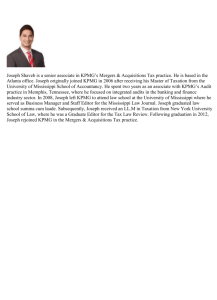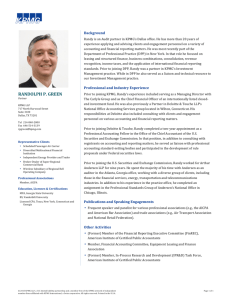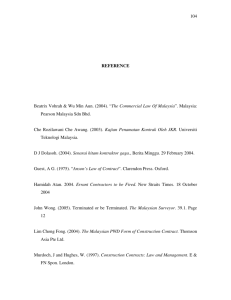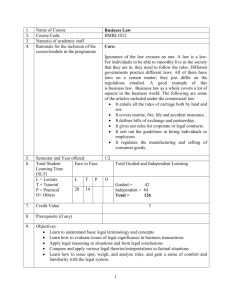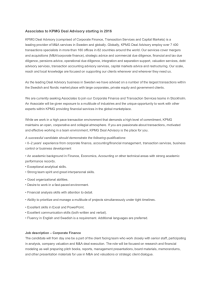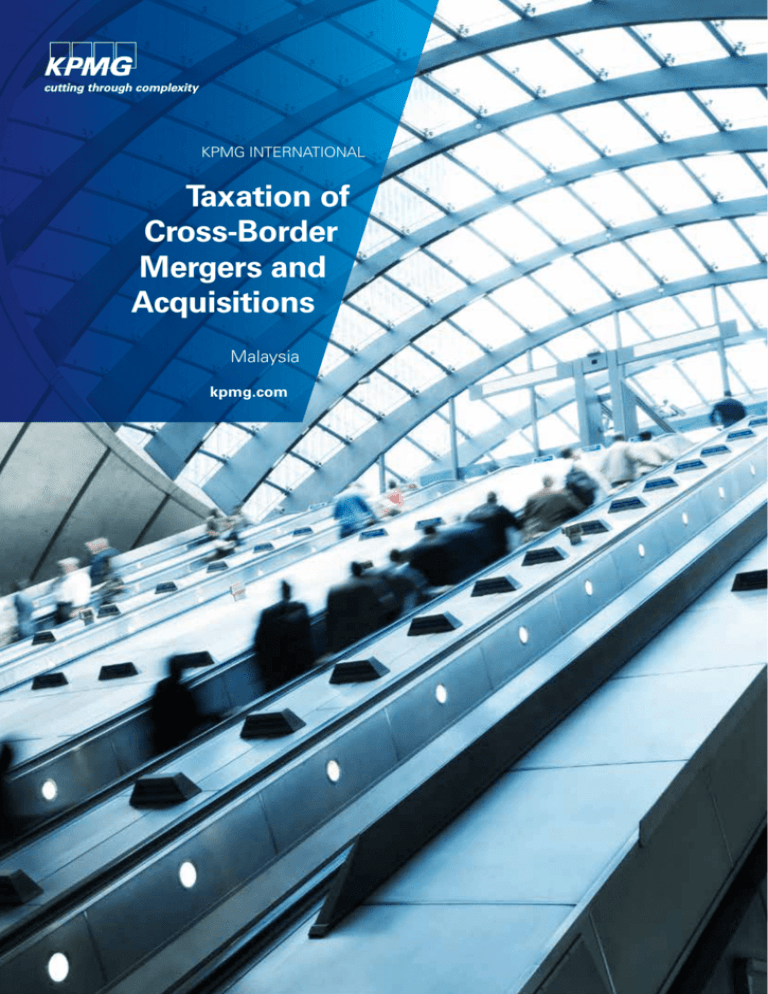
KPMG International
Taxation of
Cross-Border
Mergers and
Acquisitions
Malaysia
kpmg.com
2 | Malaysia: Taxation of Cross-Border Mergers and Acquisitions
Malaysia
Introduction
Recent developments
Malaysia is a member of the British Commonwealth and its
tax system has its roots in the British tax system. the British
introduced taxation to the Federation of Malaya (as Malaysia
was then known) in 1947, during the British colonial rule with
Income tax ordinance, 1947. the ordinance was repealed with
the enactment of the Income tax act, 1967, which came into
effect on 1 January 1968, and further tax legislation has since
been introduced.
Malaysia has gradually reduced its corporate tax rates from
27 percent in year of assessment (Ya) 2007, to 26 percent
in Ya 2008, and to 25 percent for Ya 2009 to Ya 2015. the
2014 Budget proposes to reduce the rate to 24 percent from
Ya 2016 onwards, in a move to keep Malaysia competitive
in the region.
the current principal direct taxation legislation consists of the
following:
• Income tax act, 1967 (Ita), which provides for the
imposition and collection of income tax
• real Property Gains tax act, 1976 (rPGt act), which is
imposed on profits from the disposal of real properties in
Malaysia and shares in real property companies (rPC)
• Petroleum (Income tax) act, 1967, which is imposed on
profits from petroleum operations
• Promotion of Investments act, 1986, which provides for
tax incentives for persons engaged in promoted industries
or activities
• Stamp act, 1949 (Stamp act), which imposes stamp duty
on various instruments.
In Malaysia, the Securities Commission is responsible for
implementing guidelines for regulating mergers, acquisitions
and takeovers involving public companies. the regulations
formulated for the banking and finance sectors are mainly
the responsibility of the Central Bank of Malaysia (Bank
negara). Bank negara is also responsible for currency flows
to and from the country. For mergers and acquisitions (M&a)
involving parties undertaking manufacturing activities, the
approval of the Ministry of International trade and Industry
may be required. Guidance on government policies and
procedures can be obtained from the Malaysian Investment
Development authority (MIDa) – formerly known as the
Malaysian Industrial Development authority – which is the
government’s principal agency for the promotion of the
manufacturing and services sectors in Malaysia.
In addition, the Malaysian government introduced the
following notable changes in its 2014 Budget:
• implementation of Goods and Services tax from
1 april 2015
• increase in rPGt as 1 January 2014; chargeable gains are
now taxed at the following rates:
– 30 percent for disposals within 3 years after acquisition
– 20 percent for disposals in the 4th year after acquisition
– 15 percent for disposals in the 5th year after acquisition
– 5 percent for disposals more than 5 years after
acquisition
– disposals by an individual who is a Malaysian citizen or
permanent resident more than 5 years after acquisition
are exempt
– for an individual who is not a Malaysian citizen
or permanent resident, a 30 percent rate applies
for disposals within 5 years after acquisition and
a 5 percent rate applies for disposals more than
5 years after acquisition
• deadline for applications for tax incentives for new
investments in 4 and 5 star hotels in Peninsular Malaysia,
Sabah and Sarawak extended to 31 December 2016.
© 2014 KPMG International Cooperative (“KPMG International”). KPMG International provides no client services and is a Swiss entity with which the independent member firms of the KPMG network are affiliated.
Malaysia: Taxation of Cross-Border Mergers and Acquisitions | 3
Asset purchase or share purchase
Generally, in the Malaysian context, M&a transactions are
undertaken via the acquisition of shares or a business (such as
an asset purchase).
Purchase of assets
Purchase price
Generally, the acquisition price is not deductible (it is a capital
cost) except for the cost incurred to acquire qualifying assets
in an asset purchase deal (as discussed later in this chapter).
Goodwill
For tax purposes, the amount of goodwill written off or
amortized to the income statement of the company is
non-deductible on the grounds that the expense is capital
in nature.
Depreciation
the Ita contains provisions for granting initial and annual
tax-depreciation allowances on qualifying capital expenditure
incurred in acquiring or constructing industrial buildings
(as defined) and qualifying plant and machinery used for
the purposes of the taxpayer’s business (subject to certain
conditions). the main rates of initial and annual allowances are
as follows:
Type of
allowance
Initial
allowance
Annual
allowance
Industrial building
10 percent
of qualifying
expenditure
3 percent of
qualifying
expenditure
Heavy machinery
and motor
vehicles
20 percent
of qualifying
expenditure
20 percent
of qualifying
expenditure
Plant and
machinery
(general)
20 percent
of qualifying
expenditure
14 percent
of qualifying
expenditure
Office equipment,
furniture and
fittings and others
20 percent
of qualifying
expenditure
10 percent
of qualifying
expenditure
Source: KPMG in Malaysia, 2014
In addition to these allowances, the Ita allows (among
other things):
• a tax deduction for capital expenditure on replacement
assets that have a life span of 2 years or less and are used
for the purposes of the taxpayer’s business (e.g. bedding
and linen, crockery and glassware, cutlery and cooking
utensils, and loose tools)
• accelerated capital allowance for Information and
Communication technology (ICt) equipment (including
computers and software), effective from Ya 2009 to
Ya 2013 and, under a Budget 2014 proposal, to Ya 2016
• a capital allowance equal to the amount of that
expenditure is given for small value assets that each cost
up to 1,000 Malaysian ringgits (MYr) where the total
capital expenditure of such assets generally does not
exceed MYr10,000 (the limit of MYr10,000 does not
apply to small and medium enterprises)
• accelerated capital allowance for security and surveillance
equipment (effective from Ya 2008 to Ya 2015).
Separate rates apply to certain capital expenditure in, among
others, the plantation, mining, forestry, agriculture and hotel
industries.
Balancing allowances or charges may be triggered when
a taxpayer disposes of a qualifying capital item (such as
industrial buildings and plant and machinery).
a balancing allowance arises when the asset’s market value
or sale price, whichever is higher, is lower than the asset’s
residual or tax written-down value. a balancing charge arises
when the asset’s market value or sale price, whichever is
higher, exceeds the asset’s residual or tax written-down value.
However, the amount of balancing charges to be imposed
is limited to the amount of capital allowance claimed on
the asset prior to its disposal. Capital allowances claimed
on qualifying assets that are disposed of within 2 years
may be subject to clawback at the discretion of the Inland
revenue Board (IrB). this typically applies on the disposal
of luxury goods.
the provisions on balancing allowances, balancing charges
and clawbacks are applicable unless the disposal falls within
the Ita’s controlled transfer provisions. In a controlled transfer
situation, the assets are deemed to be transferred at their
respective residual values such that no balancing charges or
allowances arises.
© 2014 KPMG International Cooperative (“KPMG International”). KPMG International provides no client services and is a Swiss entity with which the independent member firms of the KPMG network are affiliated.
4 | Malaysia: Taxation of Cross-Border Mergers and Acquisitions
A
purchasing the items must officially inform the royal
Malaysian Customs of the change in ownership.
For the purchasing company to enjoy the tax/duty exemption
on the goods purchased, an application must be made to the
Minister of Finance (MoF) to inform the MoF of the transfer
of ownership and to obtain an approval to extend the tax/duty
exemption to the purchasing company.
Where the exemption is granted based on the same grounds
as stated previously by the vendor company, the company
purchasing the goods must adhere to the same conditions
attached to the exemption (e.g. the machinery, equipment
and raw materials must be used to manufacture the same
finished product).
typically, an asset sale triggers an obligation for the seller
to cancel or modify existing indirect tax licenses and for the
acquirer to apply for new licenses.
It is proposed that, as of 1 april 2015, a GSt will be implemented
in Malaysia to replace the sales tax and service tax.
Transfer taxes
the stamp duty imposed on the disposal of property (except
stock, shares, marketable securities and accounts receivable
or certain book debts) is based on the value of the transaction.
For every MYr100 or fraction thereof of the monetary value
of the consideration or the market value of the property,
whichever is greater, the rates of stamp duty are as follows:
• MYr1 on the first MYr100,000
• MYr2 on any amount in excess of MYr100,000 but not
exceeding MYr500,000
• MYr3 on any amount in excess of MYr500,000.
the rates imposed on other instruments are outlined in the
First Schedule of the Stamp act.
Several kinds of relief are provided in the Stamp act, including
two key reliefs relating to M&a.
Section 15 of the Stamp act provides relief from stamp duty in
connection with a plan for the reconstruction or amalgamation
of companies if the following conditions (among others)
are met:
• the transferee company must be registered or
incorporated in Malaysia, or have increased its capital
with a view to acquiring the undertaking of, or not less
than 90 percent of the issued share capital of, any
existing company.
© 2014 KPMG International Cooperative (“KPMG International”). KPMG International provides no client services and is a Swiss entity with which the independent member firms of the KPMG network are affiliated.
Malaysia: Taxation of Cross-Border Mergers and Acquisitions | 5
• not less than 90 percent of the consideration for the
acquisition (other than that relating to the transfer to, or
discharge by, the transferee company of liabilities of the
existing company) consists of:
– the issue of shares (when an undertaking is to be
acquired) in the transferee company to the existing
company or to holders of shares in the existing company
– the issue of shares (when shares are to be acquired) in
the transferee company to the holders of shares in the
existing company in exchange for the shares held by
them in the existing company.
the approval of the collector of stamp duties is required, and
anti-avoidance provisions under section 15 may claw back the
stamp duty relief (if granted) under certain circumstances.
Section 15a(2) of the Stamp act provides relief from stamp
duty in the case of a transfer of property between associated
companies on any instrument if the collector of stamp duties
is satisfied that (among other things):
• the effect of the transaction is to transfer a beneficial
interest in property from one company with limited liability
to another company and the companies are associated
(i.e. one company is the beneficial owner of at least
90 percent of the issued share capital of the other)
• a third company with limited liability is the beneficial
owner of not less than 90 percent of the issued share
capital of each of the companies.
there are also anti-avoidance provisions in section 15a.
the Stamp act empowers the MoF to exempt specific
transactions from stamp duty, but this power is rarely
exercised.
incentives currently enjoyed by the target Malaysian company
and any conditions attached to them.
Regulatory issues
limitations on foreign ownership apply to some extent to a
purchase of shares.
a locally owned company may deduct 20 percent of the cost
of acquiring a foreign-owned high technology company each
year over a period of 5 Yas (subject to certain conditions).
Indirect tax issues
Compared to an asset purchase, indirect tax issues are less
significant in the context of a share purchase. However, any
historical liabilities that exist remain with the target company
despite the change in ownership.
Tax indemnities and warranties
tax indemnities and warranties are discussed in this chapter’s
section on tax clearances.
Tax losses
losses and capital allowances not used in a Ya can be carried
forward indefinitely, provided the company is not dormant.
If the company is dormant, it must satisfy the IrB that more
than 50 percent of its shareholders on the last day of the basis
period in which the losses or capital allowances arose are
the same as on the first day of the basis period in which the
unabsorbed losses or capital allowance are to be used.
Unused business losses may be set off against income from
any business source. However, unused capital allowances
may only be set off against income from the same business
source in which the capital allowances arose.
Purchase of shares
Tax incentives
tax incentives are granted to companies that undertake
promoted activities. a change in ownership of a Malaysian
company enjoying any tax incentive should not affect the tax
incentive granted as long as the company continues to carry
out the promoted activity granted under the tax incentive.
However, there are instances where the Malaysian tax
incentive is granted with equity conditions attached, whether
directly or indirectly. In these cases, the change in ownership
of the company enjoying the incentive may affect the grant of
such incentives. as such, it is advisable to ascertain the tax
Crystallization of tax charges
the advisors to the prospective purchaser may undertake a
due diligence review of the books and records of the target
company to ascertain the tax position of the target company
and identify potential tax liabilities.
Pre-sale dividend
Generally, a company is allowed to pay pre-sale dividends.
Dividend payments are discussed later in this chapter.
Malaysia does not impose withholding tax (WHt) on dividend
payments.
© 2014 KPMG International Cooperative (“KPMG International”). KPMG International provides no client services and is a Swiss entity with which the independent member firms of the KPMG network are affiliated.
6 | Malaysia: Taxation of Cross-Border Mergers and Acquisitions
Transfer taxes
transfers of shares in an unlisted Malaysian company
attract stamp duty at the rate of 0.3 percent of the value of
shares transferred. Based on the guidelines issued by the
IrB’s Stamp Duty Unit on 21 april 2001, the value of shares
transferred for stamp duty purposes is the highest value of
the following:
• par value
• net tangible assets (nta)
• price-earnings multiple or price-earnings ratio
• actual sale consideration.
the transfer of securities on the Central Depository System
does not attract ad valorem stamp duties at 0.3 percent;
instead, the contract notes may attract stamp duty at
0.1 percent. However, according to Stamp Duty remission
order 2003, all contract notes relating to the sale of any
shares, stock or marketable securities listed on a stock
exchange approved under subsection 8(2) of the Securities
Industry act 1983, are waived from stamp duty in excess of
MYr200 calculated at the prescribed rate in item 31 of the
First Schedule to the Stamp act.
reliefs available for stamp duty and transfer taxes are
discussed earlier in this chapter.
Tax clearances
It is seldom possible to obtain a clearance from the IrB (or
from the royal Malaysian Customs) giving assurance that a
potential Malaysian target company has no tax arrears without
tax or customs audits taking place. therefore, it is usual to
include tax indemnities and warranties in the sale agreement.
the extent of the indemnities or warranties is subject to
negotiation between the vendor and purchaser.
as noted, the advisors to the prospective purchaser may
undertake a due diligence review of the books and records of
the target company to ascertain the tax position of the target
company and to identify potential tax liabilities.
Choice of acquisition vehicle
Local holding company
Foreign companies commonly set up Malaysian-resident
holding companies to acquire shares or assets in Malaysia.
regardless of where a holding company is incorporated, it
is considered a tax-resident in Malaysia if it is managed and
controlled in Malaysia. Generally, a company is regarded as
being managed and controlled in Malaysia if its directors’
meetings are held there.
Historically, Malaysia adopted the imputation system of
dividend payments, in which the corporate income tax paid
by a company on its profits was fully passed on or imputed
to the shareholders when a dividend (other than an exempt
dividend) was paid. therefore, the dividend was paid net of
tax but had an imputation tax credit attached. a company
receiving taxable dividends from a Malaysian resident
company was taxable at the appropriate corporate income tax
rate but could claim the tax credit attached to the dividend to
offset the resulting tax liability. thus, one advantage of using
a Malaysian resident holding company to hold shares in a
Malaysian resident target company was the ability to claim a
refund of tax credits when there was sufficient interest cost
to offset the taxable dividend income.
as of 1 January 2008, a single-tier system replaced the
imputation system. Under the new system, the tax payable
by a resident company constitutes a final tax. Dividends
paid under the single-tier system are tax-exempt in the
hands of shareholders. transitional provisions allowed the
imputation system (with some amendments) to be used until
31 December 2013. Under the single-tier system, tax relief
can no longer be obtained by offsetting interest expense
against dividend income because dividends are tax-exempt.
Surplus expenses in holding companies, including those listed
on Bursa Malaysia, cannot be carried forward.
Issues of interest restriction and allocation can arise when
a company has an interest expense and a variety of incomeproducing and non-income-producing investments. as
of 1 January 2009, thin capitalization and transfer pricing
provisions have been introduced to the Ita.
Foreign-sourced income received in Malaysia by a resident
company (other than a resident company carrying on the
business of banking, insurance, shipping or air transport) is
exempt from tax (with only limited exemptions for banking
businesses). Hence, it may be advantageous to use a
Malaysian holding company to hold a foreign investment, as
foreign-sourced dividend income (including trading profits
from a foreign branch) and gains on the sale of subsidiaries are
generally not subject to tax. However, interest costs and other
costs attributed to foreign-sourced income incurred by the
Malaysian holding company to fund the foreign investment
would be wasted.
© 2014 KPMG International Cooperative (“KPMG International”). KPMG International provides no client services and is a Swiss entity with which the independent member firms of the KPMG network are affiliated.
Malaysia: Taxation of Cross-Border Mergers and Acquisitions | 7
In relation to thin capitalization, section 140a(4) of the Ita,
which has effect from 1 January 2009, provides that where
the value of all financial assistance to an associated person
is excessive in comparison to the fixed capital of the recipient
of the financial assistance, the interest, finance charge or other
consideration payable on the excess value is not deductible.
Under section 140a(5) of the Ita, an associated person is one
who has control over the recipient of the financial assistance,
is controlled by the recipient of the financial assistance, or,
together with the recipient of the financial assistance, is
controlled by a third person. It should not be assumed that
control refers only to shareholding control.
although section 140a(4) was technically effective from
1 January 2009, its actual implementation has been deferred
to the end of December 2015.
Non-resident intermediate holding company
Malaysia has concluded agreements for the avoidance of
double taxation agreements with the following countries.
(not all have been ratified, however, and not all are
comprehensive):
albania, argentina, australia, austria, Bahrain, Bangladesh,
Belgium, Bosnia, Brunei, Canada, Chile, China, Croatia,
Czech republic, Denmark, egypt, Fiji, Finland, France,
Germany, Hong Kong Special administrative region,
Hungary, India, Indonesia, Iran, Ireland, Italy, Japan, Jordan,
Kazakhstan, Kuwait, Kyrgyz, laos, lebanon, luxembourg,
Malta, Mauritius, Mongolia, Morocco, Myanmar,
namibia, netherlands, new Zealand, norway, Pakistan,
Papua new Guinea, Philippines, Poland, Qatar, romania,
russia, San Marino, Saudi arabia, Senegal, Seychelles,
Singapore, South africa, South Korea, Spain, Sri lanka,
Sudan, Sweden, Switzerland, Syria, taiwan, thailand, turkey,
turkmenistan, United arab emirates, United Kingdom,
United States, Uzbekistan, Venezuela, Vietnam,
and Zimbabwe.
Local branch
In Malaysia, both a branch and a subsidiary are generally
subject to the same tax filing and payment obligations.
Malaysia does not impose branch profits tax on the remittance
of branch profits. therefore, the profits of a local branch may
be freely repatriated back to its head office without attracting
further tax liabilities in Malaysia.
Limited liability partnership
the limited liability Partnerships (llP) act 2012 introduced
the concept of an llP.
For income tax purposes, an llP is treated as a separate legal
entity from its partners. the income of the llP is taxed at the
llP level. Consequently, the partners are not liable to tax on
their share of income from the llP (whether distributed or not).
Joint venture
a joint venture can be either unincorporated or incorporated.
If unincorporated, it needs to be determined whether it is a
partnership.
a partnership is not taxed as an entity. Instead tax is charged
at the partners’ level on their share of the adjusted income
from the partnership. the divisible income is allocated among
the partners according to their profit-sharing formula, and the
capital allowances (also allocated according to the profit-sharing
formula) are deducted from the partners’ chargeable income. If
there is a partnership loss, each partner’s share of the loss may
be offset against their income from other sources.
Choice of acquisition funding
the financing of a transaction can be in the form of shares or
loan notes, cash, asset swaps or a combination of different
types of consideration.
Debt
Where the consideration is in the form of cash, the acquirer
may have to raise external borrowings, which may involve a
variety of regulatory approvals.
Incidental costs of raising loan finance, such as legal,
rating and guarantee fees, are viewed as capital costs and so
are non-deductible (except for certain Islamic financing and
asset-backed securitizations).
Borrowings from a non-resident may require exchange
control approval.
Malaysia introduced thin capitalization legislation effective
from 1 January 2009. However, the implementation of the
legislation and publication of the related detailed rules,
including the permitted ratio, has been deferred to the end of
December 2015.
However, where profits are repatriated in the form of (among
other things) royalties, interest or payments for management
fees, Malaysian WHt may be applicable.
© 2014 KPMG International Cooperative (“KPMG International”). KPMG International provides no client services and is a Swiss entity with which the independent member firms of the KPMG network are affiliated.
8 | Malaysia: Taxation of Cross-Border Mergers and Acquisitions
Investment in foreign currency asset
Malaysian resident corporations with domestic borrowings
that wish to invest in ‘foreign currency assets’ are required
to seek prior approval from Bank negara for overseas
investments through conversion of MYr exceeding
MYr50 million per calendar year. the MYr50 million refers to
investment abroad by the resident entity and other resident
entities within its group of entities with a parent-subsidiary
relationship. the threshold for Malaysian-resident individuals
is MYr1 million per calendar year.
Malaysian residents with domestic borrowings are free
to invest in foreign currency funds maintained onshore or
offshore. Malaysian residents with no domestic borrowing
are also free to invest abroad.
Foreign currency borrowing and ringgit borrowing
a resident company is allowed to borrow any amount in
foreign currency:
• from licensed onshore banks
• from resident and non-resident entities within its group
• from its resident and non-resident direct shareholders
• through the issuance of foreign currency debt securities to
another resident.
a resident company may obtain foreign currency credit
facilities of up to MYr100 million equivalent in aggregate from
other non-residents that are not part of its group of entities.
the limit is based on the aggregate borrowing for the group of
resident entities with a parent-subsidiary relationship.
Borrowing is defined as any credit facility, financing facility,
trade guarantee or guarantee for payment of goods,
redeemable preference share, Islamic redeemable preference
share, private debt security or Islamic private debt security
other than (among others):
• operational leasing facilities
• factoring facilities without recourse
• performance or financial guarantees.
Deductibility of interest
Deductibility of interest costs is governed by sections 33(1)
and 33(2) of the Ita. a deduction may be claimed under
section 33(1) for an interest expense that is wholly and
exclusively incurred in the production of a company’s gross
income. a company with an ongoing business may deduct the
interest expense pursuant to the same section if it relates to
a loan used for the working capital purposes of the company.
an investment holding company may deduct its interest
expense against its taxable investment income pursuant to
section 33(1).
However, under the single-tier system (discussed earlier),
the interest cost incurred by an investment holding company
would be lost because the investment income (i.e. dividend
income) would be tax-exempt.
the deductibility of the interest expense would also be
restricted by section 33(2), when monies borrowed are used
directly or indirectly for non-trade purposes (e.g. investments
or loans other than for business purposes). this section
applies to companies with ongoing businesses that undertake
non-business investments. the interest restricted can only
be allocated and set off against the taxable income, if any,
derived from the non-business investments or loans to which
the monies have been applied; the interest expense cannot
be set off against business profits. Inefficiencies could arise
where these non-trade applications do not produce sufficient
taxable income because the interest expense restricted is
then lost. For companies with interest expense and non-trade
applications, managing interest restriction can be a major issue.
there are also transfer pricing and thin capitalization issues to
consider (discussed in this chapter’s section on local holding
companies).
Withholding tax on debt and methods to reduce or
eliminate WHT
Interest paid or credited to any person who is not a taxresident in Malaysia, other than interest attributable to a
business carried on by such person in Malaysia, is generally
subject to Malaysian WHt at the rate of 15 percent on the
gross amount. the rate of WHt may be reduced by a tax treaty
between Malaysia and the recipient’s country of residence.
the reduction must be supported by a certificate of residency
of the non-resident company. Interest payments to nonresident companies without a place of business in Malaysia
in respect of Islamic securities issued in any currency and
debentures issued in MYr (other than convertible loan stocks
approved by the Securities Commission or securities issued
by the government of Malaysia) are exempt from WHt. the
following interest paid or credited to a non-resident is also
exempt from WHt:
• interest paid or credited to any person in respect of
Islamic securities originating from Malaysia other than
© 2014 KPMG International Cooperative (“KPMG International”). KPMG International provides no client services and is a Swiss entity with which the independent member firms of the KPMG network are affiliated.
Malaysia: Taxation of Cross-Border Mergers and Acquisitions | 9
convertible loan stock issued in any currency other than
MYr and approved by the Securities Commission or the
labuan Financial Services authority
• income of a unit trust in respect of interest derived from
Malaysia and paid or credited by any bank or financial
institution licensed under the Banking and Financial
Institutions act, 1989 or the Islamic Banking act, 1983.
the tax withheld must be remitted to the IrB within one
month of the earlier of the paying or crediting of such amount.
If not, a penalty of 10 percent of the amount unpaid may be
imposed and deduction for the interest expense is disallowed
until the penalty and WHt are settled.
as of 1 January 2011, the IrB may impose a penalty for an
incorrect return if a tax deduction on interest expense is
claimed and the WHt and penalty are not paid by the due date
for submission of the tax. Instead of borrowing directly from
an offshore location, it may be possible to arrange funding
through labuan. Interest payments to a labuan company are
not subject to WHt (provided that the recipient is a Malaysian
tax-resident). exchange control approval may be required.
Checklist for debt funding
Where a Malaysian company is considering debt funding, the
following issues should be considered (among others):
• Malaysian WHt on interest paid or credited to a nonresident lender and whether there are ways to minimize
or mitigate the impact (as discussed earlier in this chapter)
• where the debt funding is to be received from a related
party, issues relating to the thin capitalization rules
(implementation deferred to the end of December 2015),
transfer pricing (discussed later in the chapter) and
deductibility of interest (discussed earlier in this chapter)
• Malaysian exchange controls (discussed earlier in
this chapter).
Equity
Companies must pay registration fees on the amount of
their authorized share capital. the registration fee starts from
MYr1,000 for an authorized share capital of MYr100,000 or
less, and increases gradually to MYr70,000 for an authorized
share capital above MYr100 million. the registration fee is
only deductible for companies having an authorized capital of
up to rM2,500,000 on the incorporation date.
Hybrids
a commonly used hybrid is the redeemable preference
share (rPS), which is usually treated as a form of equity
for tax purposes. the use of the rPS allows for flexibility of
redemption, which is generally regarded as a repayment of
capital (assuming it occurs on a one-off basis).
the rPS can be redeemed either out of profits that would
otherwise be available for dividends or out of the proceeds
of a fresh issue of shares made for the purposes of the
redemption. When the rPSs are redeemed other than from
the proceeds of a fresh issue of shares, an amount equal
to the nominal value of the shares redeemed has to be
transferred out of profits otherwise available for dividend
distribution to a capital redemption reserve.
the IrB has indicated that rPS distributions generally are not
treated as interest for tax purposes.
Discounted securities
Where discounted securities are issued, it must be
established whether the discount element is in the nature of
interest. If so, refer to the discussions earlier in this chapter
on debt funding.
Deferred settlement
Generally, tax relief under the Ita is claimed when incurred.
as such, where tax relief is to be claimed under the Ita, it
needs to be determined whether the relevant cost has been
incurred, even where the payment is deferred. Generally,
Malaysian WHt obligations crystallize on the earlier of paying
or crediting a non-resident.
Other considerations
Concerns of the seller
rPGt is a capital gains tax imposed on gains on disposals of
real property located in Malaysia or shares in an rPC. an rPC
is a company that owns real property in Malaysia or shares
in other rPCs to the extent the value of its real property or
shares (in other rPCs) or both, exceeds 75 percent of the total
tangible asset value of the company at the relevant time.
as of 1 January 2013, rPGt applied at an effective rate
of 15 percent on gains from the disposal of real property
or shares in an rPC within 2 years of acquisition. a
the tax implications of dividend payments are discussed in
this chapter’s section on local holding companies.
© 2014 KPMG International Cooperative (“KPMG International”). KPMG International provides no client services and is a Swiss entity with which the independent member firms of the KPMG network are affiliated.
10 | Malaysia: Taxation of Cross-Border Mergers and Acquisitions
10 percent rate applied for disposals occurring within
2 to 5 years of acquisition.
T
as of 1 January 2014, chargeable gains are taxed at the
following rates:
• 30 percent for disposals within 3 years after acquisition
• 20 percent for disposals in the 4th year after acquisition
• 15 percent for disposals in the 5th year after acquisition
• 5 percent for disposals more than 5 years after acquisition
• disposals by an individual who is a Malaysian citizen or
permanent resident more than 5 years after acquisition
are exempt
• For an individual who is not a Malaysian citizen or
permanent resident, a 30 percent rate applies for
disposals within 5 years after acquisition and 5 percent for
disposals more than 5 years after acquisition.
Generally, a gain arises when the disposal price exceeds the
acquisition price of the real property or the shares in an rPC.
the seller and acquirer of a chargeable asset must each make
a return to the IrB within 60 days of the date of disposal
(as defined) in the prescribed form, supported by the details
stipulated in the form. Where the market value of the asset is
used, a written valuation by a valuer must be submitted.
the purchaser is required to withhold and remit to the IrB
the lower of the whole amount of the money received or
2 percent of the total value of the consideration.
Exemptions
Where, with the prior approval of the Director General of the
IrB, a chargeable asset is transferred between companies
and the transferee company is resident in Malaysia, the
transfer is treated as one from which no gain or loss arises in
any of these circumstances:
• the asset is transferred between companies in the same
group to bring about greater efficiency for a consideration
consisting substantially of shares (i.e. at least 75 percent)
and the balance in cash.
• the transfer is a result of a plan of reorganization,
reconstruction or amalgamation.
• a liquidator of a company distributes the asset and the
liquidation of the company was made under a plan of
reorganization, reconstruction or amalgamation.
© 2014 KPMG International Cooperative (“KPMG International”). KPMG International provides no client services and is a Swiss entity with which the independent member firms of the KPMG network are affiliated.
Malaysia: Taxation of Cross-Border Mergers and Acquisitions | 11
T
A
© 2014 KPMG International Cooperative (“KPMG International”). KPMG International provides no client services and is a Swiss entity with which the independent member firms of the KPMG network are affiliated.
12 | Malaysia: Taxation of Cross-Border Mergers and Acquisitions
– the transfer is a result of a plan of reorganization,
reconstruction or amalgamation
– a liquidator of a company distributes the asset and the
liquidation of the company was made under a plan of
reorganization, reconstruction or amalgamation.
For transfers under the second and third bulleted item, the
scheme concerned must comply with the government’s policy
on capital participation in industry.
approval is at the IrB’s discretion, and various conditions
must be met.
Disadvantages of asset purchases
• Possible clawback of capital allowances claimed by the
vendor in the form of a balancing charge.
• Clawback of ra, if the qualifying asset is disposed of
within 5 years from the date of acquisition.
• Higher stamp duties on the transfer of certain assets.
• Benefits of any losses or unused tax attributes remain in
the vendor company.
• Benefits of incentives remain in the vendor company.
the rPGt act empowers the Minister of Finance to exempt
specific transactions from rPGt, but this power is rarely
exercised.
• Possible need to cancel and apply for various indirect
tax licenses.
Comparison of asset and share purchases
• no capital allowance or balancing charge clawbacks on
vendor and no withdrawal of ra.
Advantage of asset purchases
• the purchase price of qualifying assets (or a proportion)
may be depreciated for tax purposes in the form of capital
allowances.
• liabilities and business risks of the vendor company are
not transferred.
Advantages of share purchases
• Purchaser may be able to use and benefit from unused tax
attributes, tax incentives and franking account balances of
the target company.
• lower stamp duties payable on the transfer of shares
compared with other physical assets.
• target company may continue to enjoy tax incentives.
• Possible to acquire only certain parts of a business.
• Interest incurred to fund the acquisition of plant,
equipment and other assets that will be used in the trade
or business is generally tax-deductible.
• Purchaser may claim ra if it has incurred qualifying capital
expenditure for the purposes of a qualifying project and
has operated in that business for at least 36 months.
Where the asset is disposed of within a period of 5 years
from the date of purchase of the asset, the ra claimed
by the seller is clawed back. Where the assets for which
the ra has been claimed are acquired under a controlled
transfer in which the transferor has previously claimed ra,
the purchaser cannot claim ra on the same assets.
Disadvantages of share purchases
• Purchaser may acquire historical tax and other liabilities.
• no deduction or depreciation allowances (capital
allowances) are available for the purchase cost of shares.
• no re-basing of underlying assets.
• Purchaser may not be able to use the unused tax losses or
capital allowances available in the target company where
there is a substantial change in shareholders. However,
this only applies to dormant companies.
• Deductions for interest incurred to fund the acquisition of
shares subject to restriction.
• Purchaser may be able to claim new incentives, where
applicable.
© 2014 KPMG International Cooperative (“KPMG International”). KPMG International provides no client services and is a Swiss entity with which the independent member firms of the KPMG network are affiliated.
Malaysia: Taxation of Cross-Border Mergers and Acquisitions | 13
Malaysia – Withholding tax rates
this table sets out reduced WHt rates that may be available for various types of payments to non-residents under Malaysia’s
tax treaties. this table is based on information available up to 1 november 2013.
Source: International Bureau of Fiscal Documentation, 2014
Dividends
Individuals,
companies (%)
Qualifying
companies (%)
Interest1 (%)
Royalties (%)
Companies:
0
0
15
10
Individuals:
0
N/A
15
10
Albania
15
52
10
10
Armenia3
0
0
15
10/154
Australia5
0
0
15
15
Austria
0
0
15
10/15
Azerbaijan
0
0
15
10/15
Bahrain
5
5
5
86
Bangladesh
0
0
15
0/107
Domestic Rates
Treaty Rates
Treaty With:
Belarus
0
0
15
10/15
Belgium
15
15
10
10
Brunei
10
10
10
10
Canada
0
0
15
0/158
Chile
15
59
15
10
China (People's Rep.)
0
0
10
10/15
Croatia
10
510
10
10
Czech Republic
0
0
12
12
Denmark
0
0
–11
1012
Egypt
0
0
15
15
Fiji
15
15
15
15
Finland
0
0
15
15
France
0
0
15
10
Georgia
0
0
15
10/15
Germany
1513
5
10
7
10
5
10
8
Hong Kong
© 2014 KPMG International Cooperative (“KPMG International”). KPMG International provides no client services and is a Swiss entity with which the independent member firms of the KPMG network are affiliated.
14 | Malaysia: Taxation of Cross-Border Mergers and Acquisitions
Dividends
Individuals,
companies (%)
Qualifying
companies (%)
Interest1 (%)
Royalties (%)
Hungary
0
0
15
15
India
5
5
10
10
Indonesia
0
0
15
15
Iran
0
0
15
10
Ireland
10
10
10
8
Italy
10
10
15
15
Japan
15
514
10
1015
Jordan
10
10
15
15
Kazakhstan
10
10
10
10
Korea (Rep.)
0
0
0/1516
0/10/15
Kuwait
0
0
0
10/15
Kyrgyzstan
0
0
15
10/15
Laos
10
5
10
10
Lebanon
5
5
10
8
Luxembourg
10
5
0/10
8
Malta
0
0
15
1517
Mauritius
15
5
15
15
Moldova
0
0
15
10/15
Mongolia
10
10
10
10
Morocco
10
5
10
10
Myanmar
10
10
10
10
Namibia
10
5
10
5
Netherlands
0
0
10
0/8
New Zealand
15
15
15
0/15
Norway
0
0
–
018
Pakistan
0
0
15
0/15
Papua New Guinea
0
0
15
10
© 2014 KPMG International Cooperative (“KPMG International”). KPMG International provides no client services and is a Swiss entity with which the independent member firms of the KPMG network are affiliated.
Malaysia: Taxation of Cross-Border Mergers and Acquisitions | 15
Dividends
Individuals,
companies (%)
Qualifying
companies (%)
Interest1 (%)
Royalties (%)
Philippines
0
0
15
0/15
Poland
0
0
15
15
Qatar
10
5
5
8
Romania
0
0
15
0/12
Russia
0
0
15
10/15
San Marino
10
5
10
10
Saudi Arabia
5
5
5
8
Serbia and Montenegro19
10
10
15
10
Seychelles
10
10
10
10
Singapore
10
5
10
8
South Africa
10
5
10
5
Spain
5
020
10
721
Sri Lanka
0
0
10
10
Sudan
10
10
10
10
Sweden
0
0
10
8
Switzerland
15
5
10
10
Syria
10
5
10
10
Taiwan
0
0
10
10
Thailand
0
0
15
0/15
Turkey
15
10
15
10
Turkmenistan
10
10
10
10
Ukraine
0
0
15
10/15
United Arab Emirates
0
0
5
10
United Kingdom
10
5
10
8
Uzbekistan
10
10
10
10
Venezuela
10
5
15
10
Vietnam
10
10
10
10
© 2014 KPMG International Cooperative (“KPMG International”). KPMG International provides no client services and is a Swiss entity with which the independent member firms of the KPMG network are affiliated.
16 | Malaysia: Taxation of Cross-Border Mergers and Acquisitions
Notes:
1. Many of the treaties provide for an exemption for certain types of interest, e.g.
interest paid to public bodies and institutions or banks, or in relation to approved
or state-guaranteed loans. Such exemptions are not considered in this column.
2. the rate generally applies to participations of at least 25 percent of capital.
3. this treaty was concluded with the former USSr. the position regarding the
applicability of the USSr treaty remains unclear: currently there is no official
statement from Malaysia regarding the applicability of the in relations with these
countries. However, Malaysia continues to apply the treaty in relations with
russia. In practice Belarus, Kyrgyzstan, russia and Ukraine generally continue to
apply the former conventions, while armenia, azerbaijan, Georgia and Moldova
generally do not apply the former conventions.
4. 10 percent for payments for the use of, or the right to use, any patent, trademark,
design or model, plan, secret formula or process, or any copyright of scientific
work, or for the use of, or the right to use, industrial, commercial or scientific
equipment or information (the treaty with China includes know-how);
15 percent for payments for the the use of, or the right to use, cinematographic
films, or tapes for radio or television broadcasting or any copyright of literary
or artistic work.
5. these treaties exclude persons who are entitled to tax benefits under the tax
regime in labuan from the benefits of the respective treaty, unless they have
made an irrevocable election to be charged to tax under the normal tax regime in
Malaysia (although this proviso is only included in treaties concluded after such an
election became available).
6. royalties do not include payments in respect of the operation of oil or gas wells,
or the extraction of mineral deposits or other natural resources.
7. approved industrial royalties payable by an enterprise which is wholly or
mainly engaged in the following activities are exempt from withholding tax:
manufacturing, assembling or processing; construction, civil engineering or
shipbuilding; or electricity, hydraulic power, gas or water supply. Under the treaty
with Canada, the term “royalties” does not include any royalty or other amount
paid in respect of the operation of a mine, oil well, quarry or any other place of
extraction of natural resources or of timber or forest produce.
8. royalties do not include any payments in respect of motion picture films or tapes
for radio or television broadcasting.
9. the rate applies to dividends paid to a Chilean company which holds directly at
least 20 percent of the voting power in the Malaysian dividend-paying company.
10. the rate generally applies to participations of at least 10 percent of capital or
voting stock, as the case may be.
© 2014 KPMG International Cooperative (“KPMG International”). KPMG International provides no client services and is a Swiss entity with which the independent member firms of the KPMG network are affiliated.
KPMG in Malaysia
Nicholas Crist
KPMG tax Services Sdn
Bhd level 10, KPMG tower
8 First avenue, Bandar Utama
47800 Petaling Jaya,
Selangor Malaysia
T: +60 (3) 7721 7022
T: +60 (3) 7721 7288
E: nicholascrist@kpmg.com.my
kpmg.com
kpmg.com/socialmedia
kpmg.com/app
the information contained herein is of a general nature and is not intended to address the circumstances of any particular individual or entity. although
we endeavor to provide accurate and timely information, there can be no guarantee that such information is accurate as of the date it is received or that
it will continue to be accurate in the future. no one should act on such information without appropriate professional advice after a thorough examination
of the particular situation.
© 2014 KPMG International Cooperative (“KPMG International”), a Swiss entity. Member firms of the KPMG network of independent firms are affiliated
with KPMG International. KPMG International provides no client services. no member firm has any authority to obligate or bind KPMG International or any
other member firm vis-à-vis third parties, nor does KPMG International have any such authority to obligate or bind any member firm. all rights reserved.
the KPMG name, logo and “cutting through complexity” are registered trademarks or trademarks of KPMG International.
Designed by evalueserve.
Publication name: Malaysia – taxation of Cross-Border Mergers and acquisitions
Publication number: 131036
Publication date: May 2014

